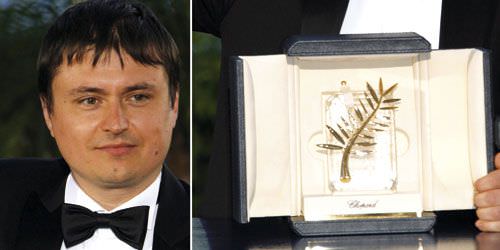The large spring watch fairs are a little like the Cannes Film Festival. At Cannes, there is, on one side, the official competition, and on the other side, the film market. In the newspapers and magazines, however, it is really only the competition that makes the pages, plus a few parallel sections. We rarely or ever hear about the film ‘market’.

The young Romanian director Christian Mungiu receiving the ‘Palme d'Or’ at Cannes 2007, for his film ‘4 months, 3 weeks and 2 days’. The ‘Palme d'Or’ has been designed and created by Chopard.
The paradox, and the merit, of the Cannes Film Festival, is that the films entered into the competition are the artiest, the most disturbing, the most engaging, and the most innovative. This is evidenced by the fact that, this year, the prestigious Palme d'Or was awarded to a small-budget film, by an unknown author, from a distressed country, Romania. Yet in terms of marketability, this film is most likely a featherweight.
While the competitors bask in the limelight, the basements of the ‘bunkers’ at the Palais du Festival are the locations where large contracts are signed, where alliances are formed, where international co-productions are created, where projects are financed: 10,500 participants, 5,000 films proposed for sale – compared to 22 films in the competition – for a turnover that is difficult to estimate, but that probably runs in the billions.
As a film critic, who tries to find the most interesting or advanced film, the ‘watch critic’, the journalist, tries to find the most surprising, the most amazing, or the most mechanically-advanced timepiece, ignoring the reality of its ‘marketability’. And, like the critic who will praise a film that hardly anyone will go to see, the watch journalist will write many pages on a limited series watch that only a few dozen people around the world will be able to afford. At Cannes, the public image of the film industry does not correspond very much to the economic reality of the sector. In the same way, whether in Basel or in Geneva, the public image of the watch industry does not correspond to the sector’s economic reality.
Europa Star, by its nature as a trade medium, must take into consideration, not only the inaccessible ‘glitter’ of the art of timekeeping, but also the ‘market’, and all that makes up the bread and butter of the watch industry, because, as for the cinema, watchmaking is sometimes an art, but above all it is an industry.
Let’s embark on the discovery of the ‘specks’, the ‘stars’, and the ‘starlets’ that parade on the red carpet. But let’s also travel the brown carpets of the industrial basements of the ‘bunkers’ with the analyses by Pierre Maillard; let’s follow the time tracks of Malcolm Lakin; let’s look at the ladies’ watch sector with Sophie Furley, and let’s look through the loupe with Keith Strandberg at the latest sports watches.
Enjoy the show and happy reading!
The Holy Horology by Pierre Maillard
Bold, black and brillant... by Malcolm Lakin
Sophie's choice by Sophie Furley
French watchmakers find their colour at BaselWorld by Antoine Menusier
Source: Europa Star June-July 2007 Magazine Issue




